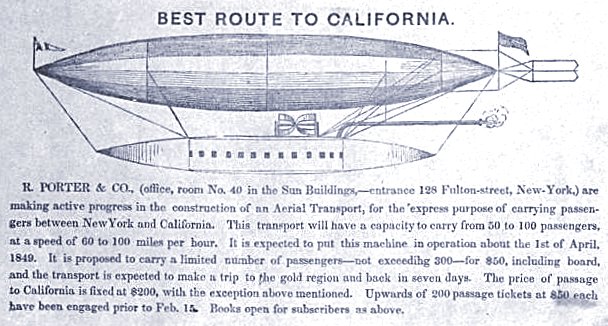An American Dirigible
Today, some thoughts on success, failure, and flying to California. The University of Houston's College of Engineering presents this series about the machines that make our civilization run, and the people whose ingenuity created them.
Success is fun, but it's not much of a teacher. Take the dirigible: Inventors began working on rigid, navigable airships just after the first manned balloon went up in 1784. Henri Giffard finally capitalized on almost seventy years of failure when he flew his three-horsepower steam-driven dirigible over Paris in 1852.
In January, 1848, four years before Giffard's flight, gold was found in California. The spring thaw saw everyone trying to get to the gold fields. But it was a daunting journey no matter how you went -- two to three thousand miles over scarcely-charted wilderness, or some eighteen thousand miles by sea around Cape Horn.
Just before the discovery of gold, an inventor named Rufus Porter had flown some model dirigibles. Now he saw a chance to get rich on the real thing. Early in 1849 he published a pamphlet entitled Aerial Navigation: The Practicality of Traveling Pleasantly and Safely from New York to California in Three Days.
He was serious. He planned to build an eight-hundred-foot steam-powered dirigible with comfortable accommodations for fifty to a hundred passengers. It'd go a hundred miles per hour. That was pretty grand thinking, but it was also a good description of the great Zeppelins that flew eighty years later. Porter went on to advertise New York-to-California service beginning in April. He wanted a fifty-dollar down payment on a two-hundred-dollar fare.
He began building immediately. His first aeroport, as he called it, was actually only 240 feet long. And it was destroyed by a tornado. Later that year, he began a seven-hundred-foot version with new backers and more support. During a showing of the almost-complete dirigible on Thanksgiving day, rowdy visitors tore the hydrogen bag. It might've been fixed, but rain got in and waterlogged the whole thing. So he started a third dirigible. A new round of technical troubles ended that one in 1854.
Porter was breathing down the neck of success, but all he actually flew was a series of large steam-powered models. His ideas were sound, but his dream was too large. We hear echoes of something Thoreau wrote at the same time that Porter was building his third aeroport:
The youth gets together his materials to build a bridge to the moon, or, perchance, a palace or temple, on the earth, and, at length, the middle-aged man concludes to build a woodshed with them.
But Porter did better than that. His ideas about the internal structure of the dirigible and partitioning the airbag were eventually used in successful airships. If he'd been a better manager and money-raiser, if he'd had a proper technological infrastructure, he might well've flown first.
And so, without failure, we'll never have success. Porter honed the technologies that gave us the really grand Zeppelins. The people who did succeed rode upon the very magnitude of Rufus Porter's visionary, gold-driven dream.
I'm John Lienhard, at the University of Houston, where we're interested in the way inventive minds work.
(Theme music)
Crouch, T.D., The Eagle Aloft: Two Centuries of the Balloon in America. Washington D.C.: Smithsonian Institution Press, 1983.
This is a rewritten version of Episode 188.

Porter's advertisement